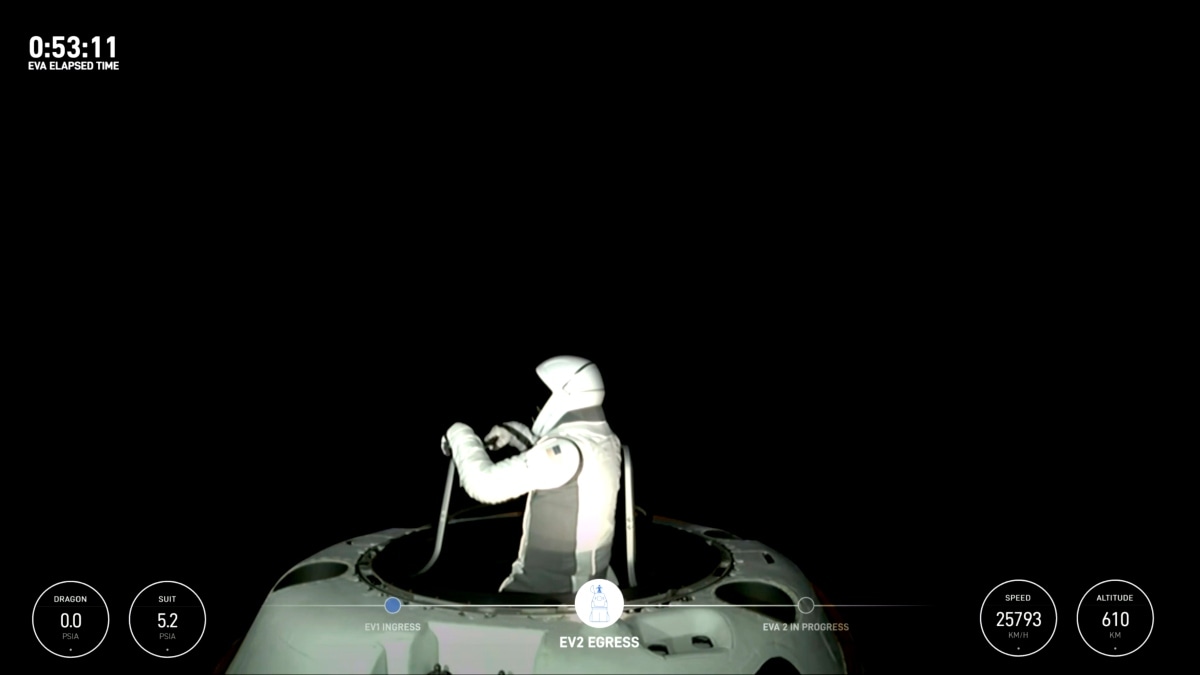
700 KM HIGH AT 30,000KM/H, POLARIS DAWN ASTRONAUTS COMPLETE FIRST COMMERCIAL SPACEWALK
Two astronauts have successfully completed the first commercial spacewalk and tested SpaceX's new, streamlined spacesuits in a groundbreaking effort to advance privately funded spaceflight.
According to The Guardian report, billionaire Jared Isaacman, 41, who financed the Polaris Dawn mission, conducted the spacewalk hundreds of miles above Earth while orbiting at nearly 30,000 km/h (18,600 mph).
The historic event took place when Isaacman exited the space capsule at 11:52 a.m. BST on Thursday, added the report.
"Back at home we all have a lot of work to do, but from here Earth sure looks like a perfect world," The Guardian quoted the 41-year-old space enthusiast, who stood on a ladder looking down at Earth’s surface, as saying.
According to the report, Sarah Gillis, a senior SpaceX engineer, joined Isaacman in the first commercial spacewalk.
At 30, Gillis conducted movement tests on SpaceX’s new, streamlined spacesuit, assessing its performance in space. The test, held at an altitude of 435 miles (700 km), required the Crew Dragon capsule to be fully depressurised, so all crew members, including those inside, depended on their spacesuits for oxygen and pressure, added the report.
Until now, only government agencies have conducted spacewalks (EVAs), a challenging task typically performed from the ISS or Tiangong space station. However, private companies are increasingly leading spaceflight efforts as government funding shifts.
NASA, for instance, has contracted SpaceX to land astronauts, including the first woman, on the moon within the decade, reported The Guardian.
NASA chief Bill Nelson praised Thursday’s successful EVA as a major advance for commercial space and NASA’s goal of a vibrant US space economy. The Polaris Dawn mission, funded by Isaacman, is his second costly venture into space.
Isaacman, who also funded the 2021 Inspiration4 mission, made his fortune with Shift4 and has flown both missions with SpaceX, which views them as steps toward more affordable space access.
Elon Musk’s SpaceX aims to return astronauts to the moon and eventually to Mars with its Starship rocket.
According to The Guardian, Musk's company is developing the largest and most powerful rocket ever built, called Starship, and has carried out four test flights of the 120-metre-tall system. The next is due in November.
Ian Whittaker, a space physics expert at Nottingham Trent University, told The Guardian that the success of the "first non-space agency astronaut spacewalk" was "extremely exciting for the private space industry as it is the first step on a longer road towards space tourism".
"The high cost will mean that only the ultra-rich get to experience this for now but putting this cost in the hands of businesses means that taxpayer money can be used for other purposes," he was quoted as saying.
The spacewalk lasted 30 minutes, with Isaacman and Gillis remaining on the ladder, as "walking" is impossible in microgravity. NASA defines a spacewalk as any time an astronaut exits a vehicle in space.
During their five-day Polaris Dawn mission, the crew will test deep space travel by traversing the Van Allen radiation belt and studying space radiation effects. The mission includes retired Air Force lieutenant colonel Scott Poteet and SpaceX engineer Anna Menon.
Coinciding with the spacewalk, a record 19 astronauts orbited Earth, following a Soyuz rocket's transport of two cosmonauts and a U.S. astronaut to the ISS.
With inputs from agencies
2024-09-12T17:17:34Z dg43tfdfdgfd